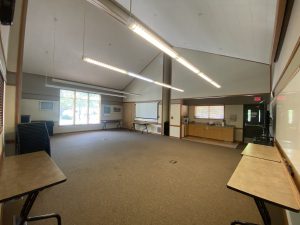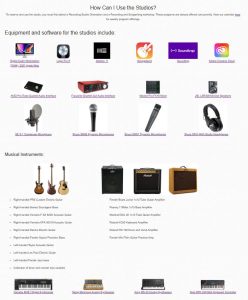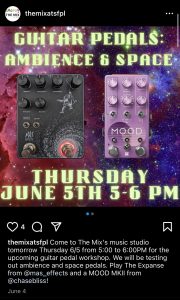Assignment X: Participatory Service and Open/Dedicated Spaces
Like others in the class, I was particularly inspired by the model of “participatory service”, and how it can be used to reinvigorate the connection between patrons and the library. Although “Library 2.0” and the Hyperlinked Service model have a basis in Web technology, in “Wholehearted Librarianship” Professor Stephens argued that Library 2.0 is about creating a meeting place that is “online or in the real world” – Hyperlinked Service isn’t hyperlinked in that it takes place exclusively online, but is hyperlinked in the sense that it is non-hierarchical and linked peer-to-peer. The challenge is, then, to design systems for delivering library services that create the possibility for and encourage these connections.
At the library branch in which I work, one of our most important and popular services is our community meeting room. At 754 square feet, it makes up a significant portion of our physical space and can accommodate up to 85 people at a time. We allow patrons to reserve the room for whatever they want to use it for, with the only stipulations being that any events hosted are free of charge. Technically, we are supposed to stipulate that any events held are open to the public, but many patrons host private events there as well without issue and it is not typically something that we are interested in enforcing. This is a relatively straightforward service: We book events in the room, outline to patrons our use policy and features of the space, and then check out keys to patrons for their reservations, but it has become a central way that our community comes together and is a thriving public space for the residents of our town. Despite our branch’s small size, our meeting room is one of the most active in our county-wide system. The room has been used for regular club meetings, like a poetry group and a folk music ensemble that practices on Saturday afternoons, activist gatherings, instructional classes and workshops, and even birthday parties. By freeing up this space to our patrons, we are able to host a wide range of events and facilitate groups that we wouldn’t be able to run on our own, allowing us to harness our patrons passions and interests and use the library to bring them to others. While this service is not unique to our library, I think it exemplifies what works about hyperlinked service. What else in the library can we open up to patron creativity and connection?
Our community meeting room.

I was also particularly inspired by the San Francisco Public Library’s “The Mix” youth space. While we have a side of our library as a dedicated “teen space” with its own computers and a young adult section, we struggle to truly accommodate them in a way that doesn’t infringe on our other patrons. We have a dedicated subset of teen patrons that visit the library daily essentially as a PC cafe where they can play Roblox and other games together and, unsurprisingly, volume is a regular issue. Ideally, we would have a specifically designated space for gaming where volume wasn’t of concern, and another space with computers for those that wanted quiet to work. Our teens rarely use the computer for other purposes, and it’s hard to blame them – it’s hardly an environment that invites focus. And while it is great that they can use the library to spend time with their friends and play games together, I also can’t help but feel that if we had more creative resources available that they would be engaged with the library in a more constructive way. Many are here almost every day, but they rarely do more than lounge on the couch or play Roblox. Often they’ll misbehave and try to provoke the staff, but I believe they’re acting out of boredom rather than malice. I wish that we were able to provide more positive stimulation and creative resources. I really liked this quote from the “Embracing Teen Service” article that Michael Casey and Michael Stephens’ which hits the nail on the head for addressing these challenges:
“Issues with teens are often larger community challenges. Kids need interesting and safe things to do. The entire community should be a part of the solution.”
Next time I’m in the Bay, I want to visit The Mix and observe how their teen patrons interact with the space and staff. I’m curious to see if the physical separation of the space allows them to feel more respected and as a result behave better, or if acting out is a fact of adolescence regardless of environment. I’d also like to see if the presence of other alternatives draws them away from video games. I love video games as much as anyone, but there can be too much of a good thing!
On the note of creative resources, I could not be more jealous of SFPL not just as a staff member but as a patron, especially as a musician. I was fortunate enough to have music practice rooms with basic software for recording and digital audio workstations at my high school that my friends and I spent many lunches in, but what they have at SFPL is truly amazing and we would have been thrilled to have access to what they do. In addition to recording setups they can use Logic AND Ableton as their DAWs. In high school, Logic’s relatively affordable $200 price tag was out of our budgets – we may or may not have shared one bootleg copy on a thumb drive instead. But Ableton Live even with a student discount is usually upwards of $400, out of the question for most high schoolers. With these tools being so expensive, it’s wonderful that teens can still learn these creative skills and try out professional tools without needing to pay or worse, to take risks in trying to pirate software.

https://sfpl.org/teens/the-mix/media-production
The hardware offerings are just as generous: they have mixers, speakers, microphones of various types, and guitars, even multiple left-handed ones. They offer various amplifiers as well, and they even have my own personal home amp – the Fender Pro Junior. Between that amp, a guitar, audio DAW, audio interface, and monitor speakers, the majority of my collection of music related equipment that I have collected over the years, costing well upwards of $1000, could be used there free of charge. But that’s not even all – they literally not only have synthesizers, they have Korg AND Moog(!) analog synthesizers. For analog synthesis fans, these are the big two names, and these specialized pieces of gear carry quite a heavy price tag with the Moog Minimoog costing $5000 new. It’s never something I really got into myself, but if I could have tried them out, who knows? Another awesome music related thing they do is host guitar pedal workshops where they demo and try out different guitar effects. In terms of participatory service, it’s clear that whoever is running the space loves music and knows their stuff, and the offerings reflect a deep understanding of what musicians would want and need.

The Mix on Instagram, promoting a guitar pedal demo
I think a mix of open-use and dedicated spaces like our community meeting room and SFPL’s media production centers can provide a model for how to structure library space in a way that meets patron needs and stimulates their curiosity and creativity. Going forward, we need to critically examine how our space and resources are being used and be open to repurposing or rebuilding so that these Library 2.0 “meeting spaces” have a real-world component.
References:
Casey, M. & Stephens, M. (2008, May 15). Embracing service to teens. Tame the Web. https://tametheweb.com/2008/05/15/embracing-service-to-teens/
O’Brien, C. (2019, June 24). How San Francisco’s public libraries are embracing their changing role. Shareable. https://www.shareable.net/how-san-francisco-public-libraries-are-embracing-their-changing-role/
Stephens, M. (2019). Wholehearted librarianship: Finding hope, inspiration, and balance. ALA Editions.
One Comment
Carly G
It really is tough to create this kind of teen space when you don’t have physical seperation from the rest of the library. I’ve worked at branches that do have it and branches that don’t, and the difference is night and day. When teens are shoehorned into the children’s or adult spaces, they often either act out or stay away entirely. Being able to have a cordoned off area is so, so helpful and such a luxury!